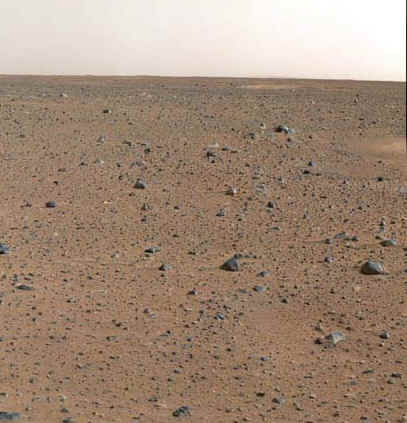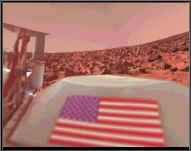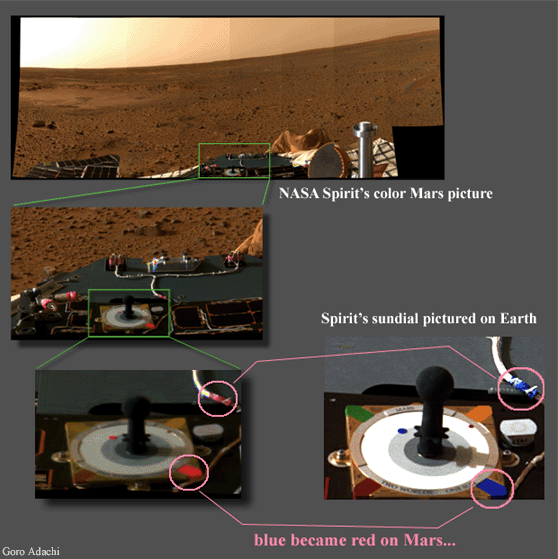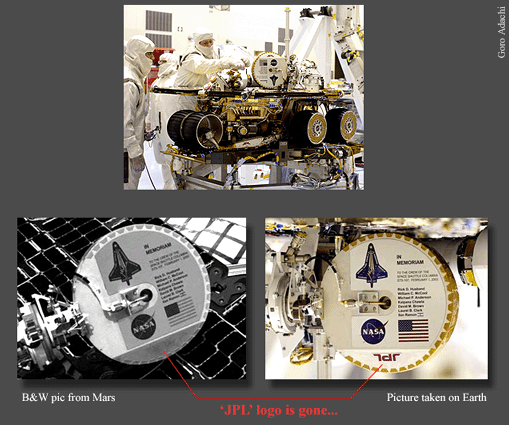Patience is a virtue my friend

Shown below is the first color picture from Spirit. The one on the left is the official NASA version, and the one on the right is an adjusted, or re-adjusted, version of the same picture in which there is reduced redness. Which appears more natural or real to you? (Click on the pictures to see larger versions.)


Of course, it could be that the Martian landscape is really as red as the NASA version shows. But given that it's scientifically acceptable for the Martian sky to be more or less blue, combined with the fact that we have quite compelling photographic evidence like one shown below from the Viking missions exposing the excessive redness of the original pictures released by NASA (the adjusted version on the right shows the colors of the American flag accurately), it is not so farfetched to suppose that NASA has been deceiving all of us about the real appearance of Mars all these years. [The 'correct' image below was produced by Barry Arneson (?) in 2001.]


January 7-8: Canadian Press/Yahoo! News has posted an earth-like color version of the Mars picture from the NASA Spirit rover that is identical to the one used in my Jan. 7 post which was quickly produced with Photoshop.
Comparison ('official' version left; 'Canadian' version right):


January 8-9: NASA sends mixed signals [source]. Here are two versions of the same Martian picture from Spirit posted on two different NASA webpages:


By creating this kind of confusion, it becomes easier to gradually phase out the probably misleading, red Mars appearance familiar to us and bring in the more earth-like, 'real' pictures of Mars... But that's still just a theory.
January 9: Here is more (apparent) evidence of color 'manipulation' being done - deliberately or accidentally - by NASA. The illustration below I just produced should make the discrepancies rather plain. Very strange. (Pictures used in the illustration are from here and here.)
Update: The color change of the 'sundial' is not necessarily a sign of a 'conspiracy', but it does suggest, well actually it's a given, that the photo was not quite correctly calibrated. As Keith Laney states:
So far the only image showing the calibration target in the same view as the surface and sky showed conclusively that the image was not calibrated properly. The blue is hot pink, the green is virtually nonexistent and the red is brown. This explains the ruddy caste to the ground and sky in this otherwise beautiful image.

And here is another curious photographic anomaly brought to my attention...

What does this mean? Who knows... If you're puzzled, you're certainly not alone.
January 10-11: A light-blue sky of Mars shown during a NASA news conference (Jan. 10). I guess if the NASA guys don't make a big deal of the shifting colors of Mars, the media won't find it strange either. If this keeps up, Earth-like Mars images will become 'normal' rather quickly.

January 12: NASA released a 360-degree panoramic picture of the Martian surface. Well, it's still very red and the sundial area has been rather conveniently cut out from this photo.

January 13: On January 11, Keith Laney (a photo-processing expert) posted his carefully processed Spirit picture from Mars which he believes shows the true colors of Mars. In an online forum he gave us the following information:
Making sense of the Pancam and color
looking into this, we can see that actually the Pancam isn't true color, but it is close, a lot closer than Ody [Odyssey?]. Not that the representations we're seeing are correct.
"What!?!? not true color! exactly what do you mean mr. Laney?"
well, it is in sorts, but it isn't "true" because color response is actually varied depending on observer and other factors such as lighting and atmosphere. We all know that "true" RGB wavelengths are something that cannot be nailed down to a definite value, the response is more a curve. average response for RGB is a given however, and these values are..
Red 650nm+/-
Green 510nm+/-
Blue 440nm+/-
Now we get to the Pancam, which is a remarkable piece of imaging technology, and very complex. It has two "eyes", left and right. they both see differently. Here are the filter positions.
LEFT CAMERA RIGHT CAMERA
L1. EMPTY R1. 430 (SP) *
L2. 750 (20) R2. 750 (20)
L3. 670 (20) R3. 800 (20)
L4. 600 (20) R4. 860 (25)
L5. 530 (20) R5. 900 (25)
L6. 480 (25) R6. 930 (30)
L7. 430 (SP)* R7. 980 (LP)*
L8. 440 Solar ND R8. 880 Solar ND
SP means short pass filter, LP means long pass filter. one lens on each side is coated so it can observe the sun (solar ND) L1 is clear, no filter
Using this chart for reference we see that the left eye is of main use for color imaging, with values covering acceptable rgb values. This means that in order for meaningful evaluation of the color or infrared combinations produced from these images to we will have to have them displayed so that we can obtain all the bands, and in more than compressed jpeg. which doesn't seem to be the case
until then, we have to "trust 'em". which is not imaging or science.
[...] a vitally important point of [this is] that it is ENTIRELY possible for us to get unquestionably true color images out of this thing. I'm looking for more full left side imagery right now, and it will be very soon that I'm fixing to show you what Spirit says is the no **** about it true colors of this area. I just happen to have the answer for this shell game played with spectral bands.
And a little later Laney revealed his 'image showing 'Mars in true as you can get it color', adding 'It's an exciting day!'. Here it is. (Go to
www.keithlaney.com/spirit_color_images.htm for more.)

This is very different from NASA's version, that's for sure... Very Earth-like. Is this the real Mars?
Courtesy of
here